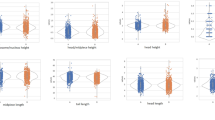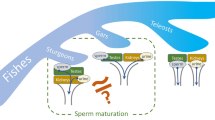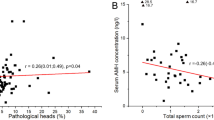Abstract
HUMAN semen has long been known to differ from that of any other mammal in the high proportion of abnormal spermatozoa that it contains1. But there has been almost no opportunity to compare human spermatozoa with those of man's closest living relatives, the chimpanzee (Pan troglodytes), the pygmy chimpanzee (Pan paniscus), the gorilla (Gorilla gorilla) and the orangutan (Pongo pygmaeus); these are all now endangered species, and the few animals in zoos are not available for experimentation. Recently, workers at the Yerkes Regional Primate Research Center, where all four species are maintained, have perfected a technique for obtaining semen from these rare animals by electroejaculation2. Preliminary studies have suggested that marked morphological similarities exist only between the spermatozoa of the gorilla and man3. We examined these similarities and differences in more detail, in the hope that spermatozoal morphology might provide some taxonomic clues about our affinities to the great apes.
This is a preview of subscription content, access via your institution
Access options
Subscribe to this journal
Receive 51 print issues and online access
$199.00 per year
only $3.90 per issue
Buy this article
- Purchase on Springer Link
- Instant access to full article PDF
Prices may be subject to local taxes which are calculated during checkout
Similar content being viewed by others
References
Bedford, M. Contr. Primat. 3, 97–139 (Karger, Basel 1974).
Warner, H., Martin, D. E. & Keeling, M. E. Ann. biomed. Engnng 3, 419–432 (1974).
Martin, D. E., Gould, K. G. & Warner, H. J. hum. Evolut. 4, 287–292 (1975).
Sumner, A. Nature 231, 49 (1971).
Manfredi Romanini, M. G. J. hum. Evolut. 1, 23–40 (1972).
Conf. Suppl. Standardization in Human Cytogenetics. Birth Defects Original Article Series I, 9. (The National Foundation, New York, 1975).
Gosden, J., Mitchell, A., Seuanez, H. & Gosden, C. Chromosoma 63, 253–271 (1977).
Bedford, M., Bent, M. J. & Calvin, H. J. reprod. Fert. 33, 19–29 (1973).
Chandley, A. et al. Ann. hum. Genet. 39, 231–254 (1975).
Kajii, T. & Ohama, K. Nature 268, 633–634 (1977).
Beatty, R. A. Physiology and Genetics of Reproduction Part A (ed. Coutinho. A. M. & Fuchs, F.) (Plenum, New York, 1974).
Baccetti, B. & Afzelius, B. A. Monographs in Developmental Biology (Karger. Basel, 1976).
Seuanez, H., Robinson, J., Martin, D. E. & Short, R. V. Cytogenet. Cell. Genet. 17, 317–326 (1976).
Seuanez, H. thesis. Univ. Edinburgh (1977).
Author information
Authors and Affiliations
Rights and permissions
About this article
Cite this article
SEUANEZ, H., CAROTHERS, A., MARTIN, D. et al. Morphological abnormalities in spermatozoa of man and great apes. Nature 270, 345–347 (1977). https://doi.org/10.1038/270345a0
Received:
Accepted:
Issue Date:
DOI: https://doi.org/10.1038/270345a0
This article is cited by
-
Semen collection, evaluation, and cryopreservation in the bonobo (Pan paniscus)
BMC Zoology (2022)
-
Falling sperm counts twenty years on: where are we now?
Asian Journal of Andrology (2013)
-
Parasperm: morphological and functional studies on nonfertile sperm
Ichthyological Research (2007)
-
Cytogenetic analysis of human spermatozoa using intracytoplasmic sperm injection into mouse oocytes
Russian Journal of Genetics (2005)
-
Genome size and «C-heterochromatic-DNA» in man and the african apes
Human Evolution (1990)
Comments
By submitting a comment you agree to abide by our Terms and Community Guidelines. If you find something abusive or that does not comply with our terms or guidelines please flag it as inappropriate.



